Related Research Articles

Michelangelo Merisi da Caravaggio, known mononymously as Caravaggio, was an Italian painter active in Rome for most of his artistic life. During the final four years of his life, he moved between Naples, Malta, and Sicily until his death. His paintings have been characterized by art critics as combining a realistic observation of the human state, both physical and emotional, with a dramatic use of lighting, which had a formative influence on Baroque painting.
Maltese is a Semitic language derived from late medieval Sicilian Arabic with Romance superstrata. It is spoken by the Maltese people and is the national language of Malta, and the only official Semitic and Afroasiatic language of the European Union. According to John L. Hayes, it descended from a North African dialect of Colloquial Arabic which was introduced to Malta when Arab and Berber (Aghlabids) invaders captured it in 869/870 CE. It is also said to have descended from Siculo-Arabic, which developed as a Maghrebi Arabic dialect in the Emirate of Sicily between 831 and 1091. As a result of the Norman invasion of Malta and the subsequent re-Christianization of the islands, Maltese evolved independently of Classical Arabic in a gradual process of latinisation. It is therefore exceptional as a variety of historical Arabic that has no diglossic relationship with Classical or Modern Standard Arabic. Maltese is thus classified separately from the 30 varieties constituting the modern Arabic macrolanguage. Maltese is also distinguished from Arabic and other Semitic languages since its morphology has been deeply influenced by Romance languages, namely Italian and Sicilian.

Catacombs are man-made underground passages primarily used for religious purposes, particularly for burial. Any chamber used as a burial place is considered a catacomb, although the word is most commonly associated with the Roman Empire.

The Sovereign Military Order of Malta (SMOM), officially the Sovereign Military Hospitaller Order of Saint John of Jerusalem, of Rhodes and of Malta, and commonly known as the Order of Malta or the Knights of Malta, is a Catholic lay religious order, traditionally of a military, chivalric, and noble nature. Though it possesses no territory, the order is often considered a sovereign entity under international law.

Maltese dog refers both to an ancient variety of dwarf, white-coated dog breed from Italy and generally associated also with the island of Malta, and to a modern breed of similar dogs in the toy group, genetically related to the Bichon, Bolognese, and Havanese breeds. The precise link, if any, between the modern and ancient breeds is not known. Nicholas Cutillo suggested that Maltese dogs might descend from spitz-type canines, and that the ancient variety probably was similar to the latter Pomeranian breeds with their short snout, pricked ears, and bulbous heads. These two varieties, according to Stanley Coren, were perhaps the first dogs employed as human companions.
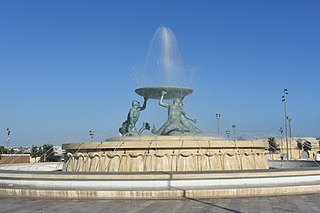
The Tritons’ Fountain is a fountain located in Floriana, Malta. It consists of three bronze Tritons holding up a large basin, balanced on a concentric base built out of concrete and clad in 730 tons of travertine slabs. The fountain is one of Malta's most important Modernist landmarks.
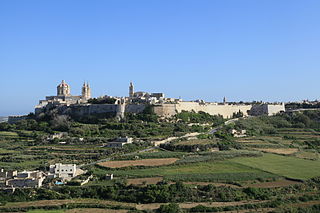
Mdina, also known by its Italian epithets Città Vecchia and Città Notabile, is a fortified city in the Northern Region of Malta which served as the island's former capital, from antiquity to the medieval period. The city is still confined within its walls, and has a population of 250.

Naxxar is a town and local council in the Northern Region of Malta. The population in March 2014 was 14,891. The Naxxar Church is dedicated to Our Lady of Victories. The annual village feast is celebrated on 8 September. It formerly hosted the Maltese International Trade Fair at Maltese International Trade Fair Grounds.

The scudo is the official currency of the Sovereign Military Order of Malta and was the currency of Malta during the rule of the Order over Malta, which ended in 1798. It is subdivided into 12 tarì, each of 20 grani with 6 piccioli to the grano. It is pegged to the euro.
Mikiel Anton Vassalli was a Maltese writer, a philosopher, and a linguist who published important Maltese language books, including a Maltese-Italian dictionary, a Maltese grammar book, the first Protestant Gospels in Maltese, and towards the end of his life, a book on Maltese proverbs.
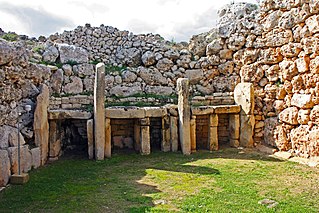
The Megalithic Temples of Malta are several prehistoric temples, some of which are UNESCO World Heritage Sites, built during three distinct periods approximately between 3600 BC and 2500 BC on the island country of Malta. They had been claimed as the oldest free-standing structures on Earth until the discovery of Göbekli Tepe in Turkey. Archaeologists believe that these megalithic complexes are the result of local innovations in a process of cultural evolution. This led to the building of several temples of the Ġgantija phase, culminating in the large Tarxien temple complex, which remained in use until 2500 BC. After this date, the temple-building culture disappeared.

The Castellania, also known as the Castellania Palace, is a former courthouse and prison in Valletta, Malta that currently houses the country's health ministry. It was built by the Order of St. John between 1757 and 1760, on the site of an earlier courthouse which had been built in 1572.
Early Christianity, otherwise called the Early Church or Paleo-Christianity, describes the historical era of the Christian religion up to the First Council of Nicaea in 325. Christianity spread from the Levant, across the Roman Empire, and beyond. Originally, this progression was closely connected to already established Jewish centers in the Holy Land and the Jewish diaspora throughout the Eastern Mediterranean. The first followers of Christianity were Jews who had converted to the faith, i.e. Jewish Christians, as well as Phoenicians, i.e. Lebanese Christians. Early Christianity contains the Apostolic Age and is followed by, and substantially overlaps with, the Patristic era.

The Beheading of Saint John the Baptist is an oil painting by the Italian artist Caravaggio. Measuring 3.7 m by 5.2 m, it depicts the execution of John the Baptist. It is located in the Oratory of St. John's Co-Cathedral in Valletta, Malta.
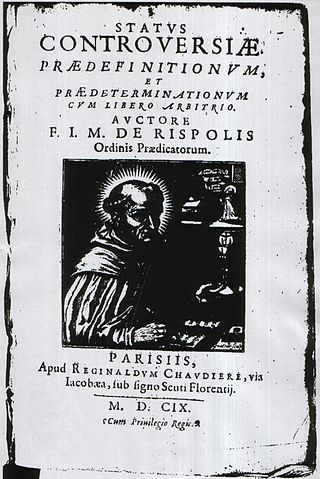
Philosophy in Malta refers to the philosophy of Maltese nationals or those of Maltese descent, whether living in Malta or abroad, whether writing in their native Maltese language or in a foreign language. Though Malta is not more than a tiny European island in the middle of the Mediterranean Sea, for the last six centuries its very small population happened to come in close contact with some of Europe's main political, academic and intellectual movements. Philosophy was among the interests fostered by its academics and intellectuals.

Hospitaller Malta, known in Maltese history as the Knights' Period, was a de facto state which existed between 1530 and 1798 when the Mediterranean islands of Malta and Gozo were ruled by the Order of St. John of Jerusalem. It was formally a vassal state of the Kingdom of Sicily, and it came into being when Emperor Charles V granted the islands as well as the city of Tripoli in modern Libya to the Order, following the latter's loss of Rhodes in 1522. Hospitaller Tripoli was lost to the Ottoman Empire in 1551, but an Ottoman attempt to take Malta in 1565 failed.

The Conspiracy of the Slaves was a failed plot by Muslim slaves in Hospitaller-ruled Malta to rebel, assassinate Grand Master Manuel Pinto da Fonseca and take over the island. The revolt was to have taken place on 29 June 1749, but plans were leaked to the order before it began; the plotters were arrested and most were later executed.

Melite or Melita (Latin) was an ancient city located on the site of present-day Mdina and Rabat, Malta. It started out as a Bronze Age settlement, which developed into a city called Ann under the Phoenicians and became the administrative centre of the island. The city fell to the Roman Republic in 218 BC, and it remained part of the Roman and later the Byzantine Empire until 870 AD, when it was captured and destroyed by the Aghlabids. The city was then rebuilt and renamed Medina, giving rise to the present name Mdina. It remained Malta's capital city until 1530.
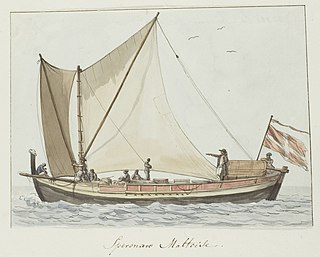
The speronara was a type of small merchant craft originating from Malta which was used in the Mediterranean from the 16th to the early 20th centuries. The vessels usually had no deck and only one mast, often with a lateen or sprit sail. Some larger vessels had a half deck or up to three masts.

The Great Siege Monument, also known as the Monument to the Fallen of the Great Siege, is a monument commemorating the Great Siege of Malta located in Valletta, Malta. It consists of three bronze figures symbolizing Faith, Fortitude, and Civilization, standing on top of a granite base. The monument is the work of the sculptor Antonio Sciortino, and it was inaugurated on 8 May 1927.
References
- ↑ Caruana, Antonio Annetto (1882). Report on the Phoenician and Roman antiquities in the group of the islands of Malta. Malta: Government Printing Office. p. 88.
- ↑ Lanciani, Rodolfo Amedeo (1897). The Ruins and Excavations of Ancient Rome: a Companion Book for Students and Travelers. Boston: Houghton, Mifflin. p. 321.